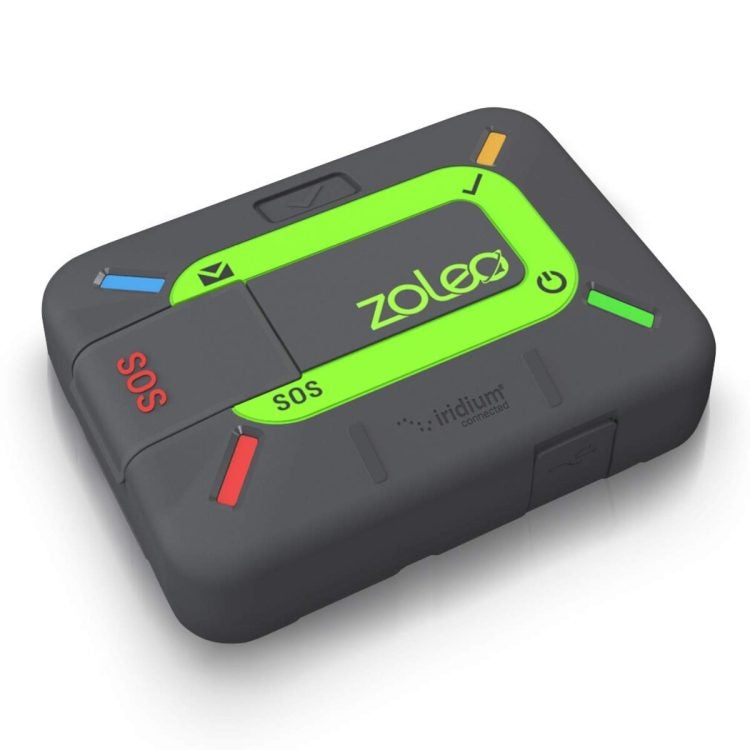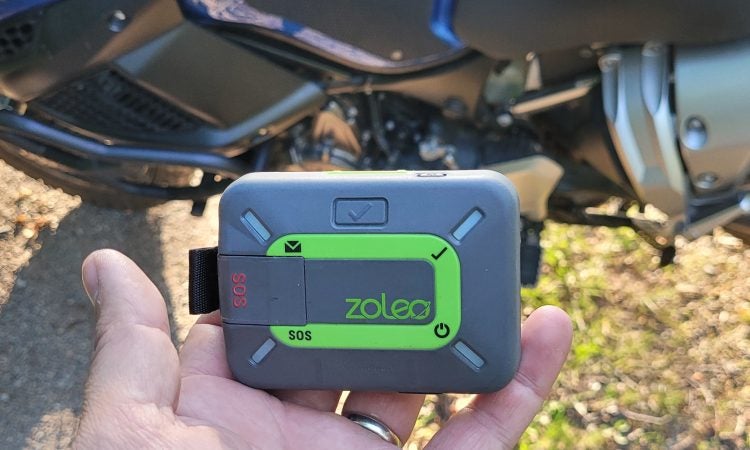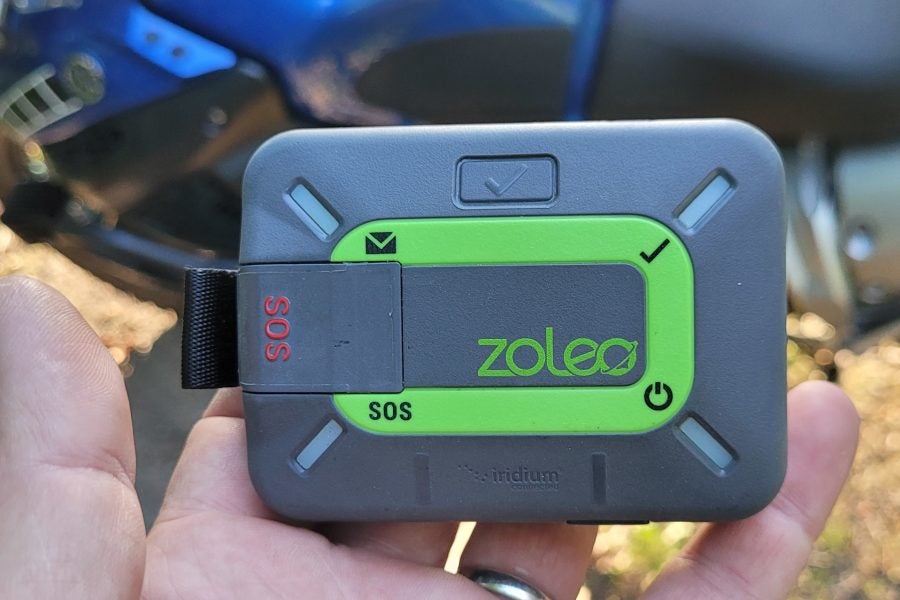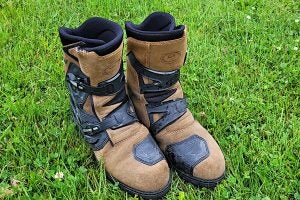I saw my first satellite tracker beacon a bit over 10 years ago. We used them to track rider teams at the Fundy Adventure Rally for both safety’s sake and for scoring. And back then, they were obviously a useful tool, one that could potentially save your life—but functionality was still limited, and the buy-in cost was too prohibitive for most riders.
That’s changed, partly due to advances in the underlying technology and partly due to the rise of competition in this market. One of those new competing companies is ZOLEO; I’ve been using a ZOLEO satellite beacon/comm unit for a while now, and I reckon this device now has this tech at a point where it is both usable and affordable enough for the average ADVer.
The ZOLEO satellite communicator
The ZOLEO satellite communicator is a small plastic gadget that fits in the palm of your hand, roughly the same size as an old flip phone. The device itself doesn’t appear very impressive. It has a couple of exterior buttons, including an SOS button covered by a flap to prevent accidental emergency alerts. A second button serves to send out “I’m OK” check-in messages, including GPS coordinates. A third button serves as power on/off switch.

The LEDs give you basic information on the device and its status. Interface with the phone app for full usability. Photo: Zoleo
A micro-USB port on the side charges the device. LED lights on top indicate battery status, and tell you when the device is on and tracking your moves, and when it has sent a message.
The device itself appears simple but has much more capability when paired with a smartphone app.

Too bad they didn’t use USB-C charging… Photo: Zac Kurylyk
Keeping safe and keeping in touch
The primary function of the ZOLEO is to serve as an GPS beacon that can guide help to your location (it uses the Iridium satellite network). If you crash your Tenere in a no-cell-service area of the Montana BDR and you need medical help, you can press the SOS button. Here’s how ZOLEO describes what happens:
When our emergency response coordination partner receives your SOS alert, they’ll know the GPS coordinates of your ZOLEO device. They will confirm your alert and contact the appropriate authorities to dispatch help. With progressive SOS from ZOLEO, you’ll also receive step-by-step status updates throughout the incident via the ZOLEO app.
Using the ZOLEO app, you’ll be able to message back and forth with emergency response coordination partner to exchange updates until your emergency has been resolved.
Even if you’re using the ZOLEO communicator on its own, without the app, you’ll get confirmation that your SOS message was received (via the LEDs on the device). How’s that for peace of mind?
Read more on the SOS function here.
ZOLEO also offers a tracking function that is closely tied to the GPS beacon’s capability. You can set the device to ping the satellite network with your geolocation at set times, then view these pings as a breadcrumb trail-type “trip” on a map that you can share through ZOLEO’s website. Like other satellite comms, this device can also be connected to Spotwalla to share this information easily.
Users can also press the “check in” button to send a one-time ping to pre-designated contacts that shares an “Everything’s OK” message, and also a GPS location (optional).

It’s small enough to fit in your pocket if needed. Photo: Zac Kurylyk
You don’t need to keep the ZOLEO connected to your phone to use its basic tracking/emergency beacon functions, although I think it greatly improves the usefulness of the emergency features. But once you connect the app to the device, its capabilities are greatly expanded. Essentially, the ZOLEO serves as a link between your phone and the Iridium satellite network, allowing two-way texting and weather service updates.
Both functions are fairly simple. The texting tab of the app uses a simple mini-keyboard touchscreen interface like any other texting app. You can set the ZOLEO to check for new messages at various time intervals, including an “always-checking” mode, which depletes the battery more quickly.
Click on the weather tab in the app, and you can get a forecast for your area sent to your phone over the Iridium network. You can also drag-and-drop a point on a map to select a forecast (provided by AerisWeather) for a different area. The forecast will give you current conditions (temperature and wind details, UV index, visibility), as well as hourly forecasts for the next 44 hours and a daily forecast for the next five days.
Note that all these functionalities are paid for by a subscription. All features are not included on a basic subscription.

A flap covers the SOS button, as safety against unwanted button-mashing. Photo: Zac Kurylyk
Using ZOLEO
Downloading the app (I installed the Android version) was easy; charging the device was easy, and so was pairing it via Bluetooth. Connecting the device to Spotwalla was easy as well—input the correct IMEI number, and you’re all hooked up—the website easily explains it here.
Once in use, the device continues to be straightforward to use. The app interface is easy to understand. However, there are a couple of caveats that I think motorcyclists should remember when they use this for adventure travel.
First, the off-grid messaging feature is fantastic. I was able to send text messages to my family from the Canadian wilderness, well outside cell range. This functionality could save your life, or at least salvage a trip in a pinch, if you needed to text someone to help you find a campsite or walk you through a mechanical fix, etc.
An example: Last summer, in the middle of a forest fire near James Bay in northern Quebec, hundreds of miles away from cell service, I met with some fellow evacuees who used their ZOLEO to get information on avoiding the blaze (and also to reassure them that we weren’t all being burned to a crisp). If you’re the adventurous type, sooner or later you’ll get into a situation where this capability will prove beneficial,
However, do not expect the same real-time messaging capability as your cellphone on a 4G tower. Even with the always-checking-for-messages function enabled, there was a noticeable delay in messaging with contacts, thanks to the intricacies of the network (remember, all messages have to be beamed through a satellite first). You can use this function for reliable communication, but don’t expect the same function as your cellphone when you’re in standard wireless coverage. As well, always-on messaging depleted the battery more quickly.
But if you want to have reliable two-way communication, hassle-free through a trip in the wilderness inside North America, or in other countries where a wireless phone may be a frustrating thing to figure out, then ZOLEO’s capability is worth considering. It’s usable in any country on earth, and that alone will make it very attractive to the long-haul traveler.
Second, I think the weather forecast function is also well worth having. If you think about it, this could be a very useful feature for someone riding in the backcountry even in North America, where a forecast may not be easy to get if you’re outside cell service. If you’re in another part of the world where you don’t understand the local language, and maybe not even their alphabet, then this could be even more valuable.
Third, I think that the tracking feature is useful, but users should realize it was designed for slower-moving hikers/canoeists/etc., not for motorcyclists. ZOLEO builds a breadcrumb trail by pinging GPS info back to the Iridium satellites, and the lowest interval current offered between pings is six minutes. A motorcycle can cover a lot of time in six minutes, and while you can view a longer trip and see the route rather easily, when you zoom in on a shorter ride, you get only a rough approximation of the route.
See the two tracks below. The first was recorded over 12-minute check-in intervals. The second was recorded with 6-minute check-ins. You can see them more easily at the links here and here.
As you can see, the six-minute intervals end up with a much closer following of the ride, but it’s imperfect.
Fourth, battery life obviously depends on several factors—how often you check in, how many messages you’re sending, etc. I found that with minimal messaging and high-frequency tracking, I could get about four days out of the battery. Stretch your GPS pings to longer intervals and you could get much more life from the battery. Of course, if you can charge the battery regularly, this is not a real concern anyway (unless you forget to do so, which I did regularly).
Would I buy one?
ZOLEO lent me this device for the test for free. But I will say that this is the first time I’ve used a communicator and thought afterwards that the pricing was affordable enough to tempt me. It does have some minor drawbacks, but those are more than offset by the affordability of the device and its subscription plans.
For years now, I’ve been riding the trails of eastern Canada solo. I’ve managed to avoid injury or serious disaster, but I’ve been in spots (through my own stupidity) where I would have been in very bad shape had something gone wrong. And when I’m not riding my motorcycle, I’m often hunting or fishing in similar locations. I’ve often though to myself that an emergency beacon is something I should consider, just for the sake of my family.
The buy-in price of $200 USD is very affordable, considering the capabilities (the SPOT Gen4 device is $50 cheaper, but doesn’t offer two-way messaging or weather). Furthermore, ZOLEO’s monthly plans seem reasonable to me, starting at $20 a month (which includes GPS tracking, SOS services and 25 free messages, and then 50¢ a message after that). That’s less than a tank of gas on many bikes these days, and while money is getting tight for many riders, the emergency capabilities of this device could insure you from far worse problems.
Plans reach a maximum of $56 US a month for unlimited messaging, and of course you can deactivate your plan if you’re not going to be using your device for a while—see more info here.
Only you can judge whether or not the plans will work for you, but for me, I think I’ll at least keep the ZOLEO around for summer riding season.







